
Opal Aboɔden abo: Abakɔsɛm, Nsɛnkyerɛnnede, Nkyerɛase & Nea Ɛkeka Ho
 Sɛ w’ani gye opals ho a, wowɔ kar a ɛyɛ anigye mu. Opal yɛ aboɔden abo a wotumi de di dwuma wɔ mmeae pii a ɛwɔ abakɔsɛm a ɛyɛ den a ɛtrɛw kɔ wiase nyinaa. Nokwarem no, wɔ wiase nyinaa akyi, efisɛ wohuu opal wɔ Mars wɔ afe 2015 mu!
Sɛ w’ani gye opals ho a, wowɔ kar a ɛyɛ anigye mu. Opal yɛ aboɔden abo a wotumi de di dwuma wɔ mmeae pii a ɛwɔ abakɔsɛm a ɛyɛ den a ɛtrɛw kɔ wiase nyinaa. Nokwarem no, wɔ wiase nyinaa akyi, efisɛ wohuu opal wɔ Mars wɔ afe 2015 mu!
Obiara nni asase so a obu opal sen Australiafo. Sɛ́ wiase no mu adwumakuw a edi kan a wɔde nneɛma ma no, Australia de wɔn opals hoahoa wɔn ho kɛse, na wɔtoo din mpo sɛ wɔn ɔman aboɔden abo wɔ 1993 mu.
Australia akyi no, opal wɔ anuonyam pii. Ɔbo no ne abohene a aban de yɛ ayeforohyia mfe 14 ne atetesɛm mu awobo a wɔde yɛ October! Pii kɔ zodiac kalenda no mu? Sɛ woyɛ Libra a, opal yɛ w’anigye zodiac ɔbo!
Wopɛ sɛ wusua pii? Wɔ akwankyerɛ yi mu no, yɛbɛbua wo nsɛmmisa a ɛfa opals ho nyinaa, efi nyansahu so kosi sɛnkyerɛnne kwan so de so.
Ansa na yebehuruw akɔ mu no, momma yɛnto nnyinaso bi.
Dɛn ne Opal?
Opal yɛ mineraloid a ɛyɛ silica ne nsu. Opal dodow no ara a wubehu no yɛ 6-10% nsu. Opals a ɛyɛ den betumi anya nsu a ɛba fam te sɛ 3% na ɛkɔ soro te sɛ 21%.
Wɔ microscope ase no, opal kura silica kurukuruwa a nsu wom a wɔaboaboa ano a wɔahyehyɛ no pɛpɛɛpɛ te sɛ Buckyball kuruwa. Opal a ɛsom bo no kurukuruwa no kɛse ne ne nsusuwii yɛ pɛ, bere a opal kurukuruwa a wɔtaa de di dwuma no kɛse gu ahorow na ɛnhyia wɔ nhyehyɛe a wɔahyehyɛ mu.
Opal a ɛsom bo kurukuruwa no ntam kwan a ɛkɔ so daa no ma hann tumi dannan, na ɛma ɛyɛ ne nsaano nkyerɛwee play-of-color . Opals a wɔtaa de di dwuma, sɛnea wɔkyerɛ ase no, ɛnkyerɛ play-of-color nanso ɛkyerɛ opalescence. Opalescence yɛ adeyɛ a wɔde aniwa hu a ɛte sɛ nea ɔbo no hyerɛn fi mu, sen sɛ ɛbɛhyerɛn wɔ soro.
Opal a ɛyɛ den no yɛ 5 kosi 6.5 wɔ Mohs nsenia a ɛkyerɛ sɛ aboɔden abo a ɛyɛ den no te sɛ abo te sɛ turquoise ne ɔsram abo.
Kenkan kɔ so na woanya opal mineral su ahorow a wɔahyehyɛ no nyinaa!
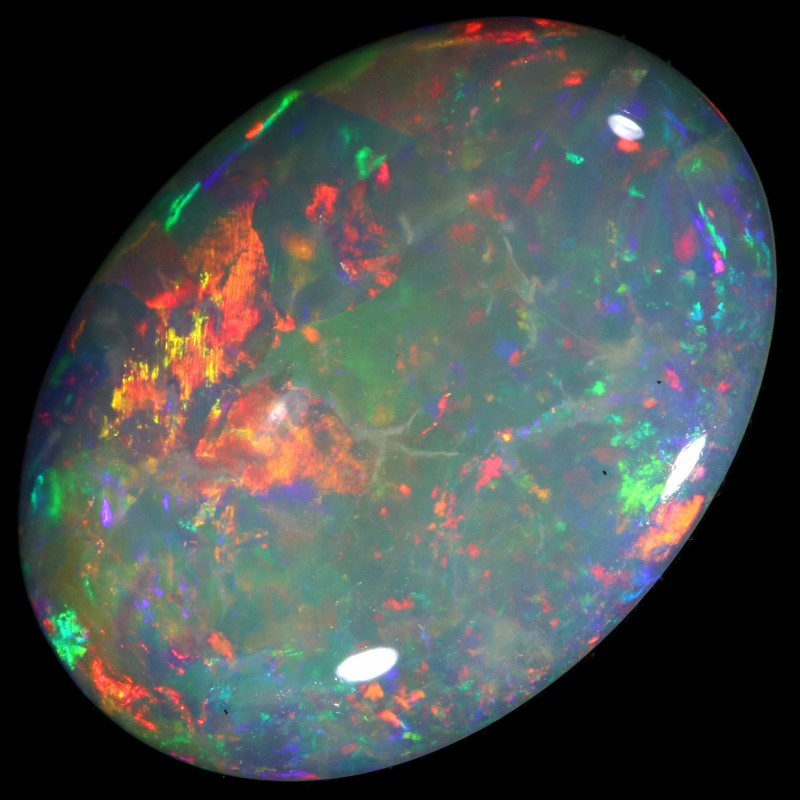
Nsɛm a Wɔakyerɛkyerɛ mu
Kɔla: Enni kɔla, fitaa, tuntum, kɔkɔɔ, borɔdɔma, kɔkɔɔ, pink, ahabammono, bruu, pink, bruu
Ahwehwɛ nhyehyɛe: Amorphous
Nneɛma a ɛyɛ den: 5-6.5
Luster: Subvitreous (ɛte sɛ ahwehwɛ kakra) kosi sɛ ɛyɛ dull
Transparency: Ɛyɛ nea ɛda adi pefee kosi nea ɛnyɛ nea ɛda adi pefee
Nneɛma a ɛma hann yɛ hyew: 1.37-1.47
Nneɛma a ɛyɛ den: 1.9-2.3
Cleavage: Biara nni hɔ
Abubuw: Conchoidal kosi nea ɛnyɛ pɛpɛɛpɛ
Luminescence: Ɛtɔ mmere bi a, ɛyɛ phosphorescence; Fluorescence (Yellow-green wɔ UV tiawa mu, fitaa anaa bruu a ɛyɛ hann wɔ UV tenten mu) .
Nyansahu no dɔɔso, momma yɛnkɔ opal abakɔsɛm a ɛyɛ anigye no mu!
Opal Abakɔsɛm & Nsɛnkyerɛnnede
Sɛ wogyina adanse a ɛwɔ hɔ so a, opal abakɔsɛm fii ase wɔ Kɔbere Mmere no mu, wɔ Kenya ɔbodan bi mu bɛyɛ afe 4000 A.Y.B.
Bere nyinaa mu no, aman ahorow anya wɔn ankasa opal nneɛma a wɔahu. Ná tete Helafo ne Romafo som opal; wɔfrɛɛ no opallios , a ɛkyerɛ “sɛ wohu kɔla a ɛsakra.”
Bere kɔɔ so no, atitiriw fii ase hyɛɛ opal nso.
Wɔ Mfinimfini Mmere no mu no, na opal bi siesiee Roma Ɔhempɔn no abotiri no mfinimfini, na wɔfrɛ no “Nyansa” esiane n’ahintasɛm a ɛyɛ nwonwa nti. England Ɔhemmaa Victoria M’ani gyee opal ho, na na metaa boaboa opal agude ano na mede ma akyɛde.
Nanso, gyidihunu guu opal abakɔsɛm ho fĩ bere tiaa bi. Efi 1830 mfe no mu no, na nkurɔfo gye di sɛ opal yɛ asɛmmɔne , na nea enye koraa mpo? Owu ho dawurubɔfo.
Nea ɛbɛyɛ sɛ opal rep bɔne no fibea kɛse ne Sir Walter Scott. Wɔ n’ayɛsɛm Anne of Geierstein , a ɔkyerɛwee wɔ 1829 mu no, ɔbea bi a n’adwene mu yɛ no naa ti nhwi a wɔde opal ayɛ no hwere ne kɔla bere a nsu kronkron ka no, na ɛno akyi bere tiaa bi no, ne wu ba.
Scott ayɛsɛm no sɛee opal gua no, na ɛmaa adetɔn so tew 50% na ɛtraa hɔ mfe du du pii.
Ɛno na Tullie Cornthwaite Wollaston baa mu.
Wollaston tee Australiafo opal a wohuu no ho asɛm wɔ 1888 mu na ohuruw faa hokwan no so. Bere a ɔde nneɛma kɔ London no, wohyiaa Wollaston adwenem naayɛ, gye De Beers a ɔyɛ daimond ho ɔbenfo nkutoo.
Wollaston de nkakrankakra maa Amerikafo ne Europafo huu opal tuntum. Bere a Percy Marks yɛɛ agude a wɔaboaboa ano a wɔagye abasobɔde a efi Australiafo opal tuntum mu wɔ 1908 mu no, opal a agye din no san kɔɔ baabi a ɛfata.
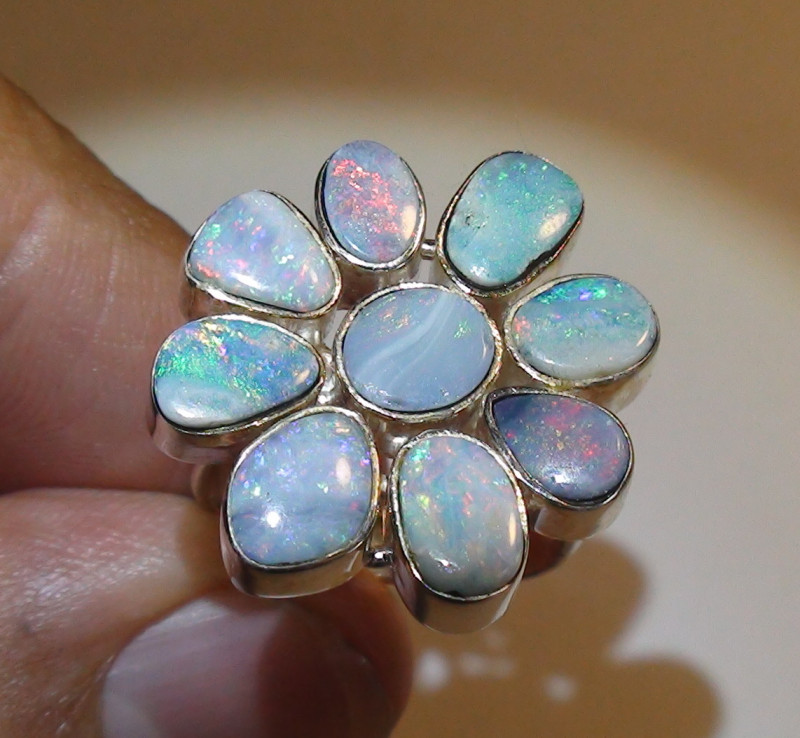
Opal Nsɛnkyerɛnnede
Bere a na opal yɛ asɛmmɔne ne asɛmmɔne ho sɛnkyerɛnne bere bi no, na saa bere no yɛ blip wɔ opal sɛnkyerɛnne kwan so bere nhyehyɛe no mu. Ansa na afeha a ɛto so 19 mu anansesɛm ahorow reba no, na aman pii hu opal sɛ ade a wɔde gye wɔn ani. Sɛ nhwɛso no, China agye opal tumi ahorow a ɛyɛ anigye adi bere nyinaa.
Opal sɛnkyerɛnnede nso kɔɔ akyiri sen da biara da anigye na ɛkɔɔ ahintasɛm asasesin mu.
Gyidi ahorow a ɛfa opal tumi a ɛfa anisoadehu ho no trɛwee wɔ tete mmere mu. Ná ebinom gye di sɛ opal betumi asa aniwa mu nyarewa, bere a afoforo kae sɛ sɛ wokura opal a wɔde bay ahaban abɔ mu a, ebetumi ama woayɛ nea wontumi nhu.
Wosusuw sɛ nea wontumi nhu no yɛ wuram? Na astral projection nso ɛ?
Bere a ɔbo no trɛw opal nkonyaayi tumi mu no, na wɔkyerɛ sɛ ɛde obi honam nipadua bata honhom fam afã no ho. Wɔ saa kwan yi so no, na opal yɛ ɔkwan a wɔfa so nya osuahu ahorow a efi nipadua no akyi. Black opal nyaa din mpo sɛ adwinnade a tumi wom ma nkonyaayifo.
Amammerɛ afoforo de opal bataa wɔn anyame ho, na wobuu ɔbo no sɛ ɔsoro akyɛde. Tete Arabfo anansesɛm ka sɛ opal fi soro nam anyinam so bae, bere a Perufo huu opal sɛ akyɛde a efi Pachamama, Incafo awo nyamewa hɔ.
Wɔ nnɛyi mmere yi mu no, honhom mu ayarehwɛfo de opal di dwuma de nya ahonhonsɛmdi tumi ahorow. Wɔtaa hu opal sɛ ɔbo a ɛsa yare a ɛyɛ nhyɛso, ahotoso, ne nkate mu ayaresa ho sɛnkyerɛnne.
Sɛ wo ho yɛ wo yaw sɛ wobɛsɔ opal honhom fam mfaso horow ahwɛ a, di akyi na sua nea ɛma opal aboɔden abo a ɛyɛ papa ansa na woatɔ w’ankasa de!
Nneɛma a Ɛma Ɛyɛ Pa ne Adetɔ
Sɛ́ wobehu bo a opal bi som no yɛ anifere, efisɛ ɔbo biara betumi ayɛ soronko kɛse wɔ nea edi hɔ no ho. Opal su ho nhwehwɛmu a edi mũ hwehwɛ sɛ wonya aniwa a ɛyɛ ɔbenfo. Nanso, nsɛnkyerɛnne pii da so ara wɔ hɔ a ɛsɛ sɛ wɔn a wɔtɔ da biara da hwehwɛ bere a wɔrepaw opal aboɔden abo no.
Ahosuo
Yɛbɛkɔ akyiri afa opal kɔla ho kakra, enti yɛbɛma wo afotuo bi a ɛfa biribiara ho a wode bɛhunu opal su denam ne kɔla so.
Anamɔn a edi kan ne sɛ wobɛhwehwɛ play-of-color. Esiane sɛ opal a ɛsom bo ho yɛ na sen opal a wɔtaa de di agoru nti, kɔla a wɔde di agoru kyerɛ sɛ ɛsom bo kɛse. Nokwarem no, kɔla a wɔde di agoru betumi afi mmeae kakraa bi a ɛwɔ soro so akosi ɔbo a nyankontɔn akata so koraa te sɛ boulder opal . Kɔla a wɔde di agoru a eye sen biara no kata ɔfasu no fã kɛse no ara so na ɛkyerɛ kɔla ahorow a ɛyɛ ma.
Wɔ opal a wɔtaa de di dwuma fam no, kɔla a ɛho yɛ na no na ɛtaa kyerɛ bo a ɛsom. Opal fitaa na abu so sen biara, na nipadua mu nne a ɛyɛ fitaa ne ahabammono di akyi pɛɛ. Kɔla ahorow a wɔntaa nhu ne opal tuntum ne opal kɔkɔɔ.
Ɛda adi pefee
Aboɔden abo a emu da hɔ kyerɛ sɛnea nneɛma dodow a wɔde ka ho wɔ hɔ ne sɛnea nneɛma a wɔde aka ho no da adi. Hyɛ no nsow sɛ ɛnyɛ nneɛma a wɔde ka ho nyinaa na ɛma ɔbo no bo so tew, efisɛ opal pii nya wɔn nipadua nne fi nneɛma a ɛfrafra bere a wɔreyɛ no mu.
Nneɛma a wɔde ka ho a ɛka opal bi pefeeyɛ grade ne abotan a ɛgye ahɔho anaasɛ nea ɛpaapae. Sɛ opals bata abo afoforo ho bere a wɔreyɛ te sɛ matrix opal anaa yowah nnuaba mu a, ne bo taa so tew. Kraman, mpaapaemu, ne mpaapaemu nyinaa ma opal ntumi ntra hɔ kyɛ.
Nneɛma a ɛda adi pefee nso betumi aka nea emu da hɔ, efisɛ opals a ɛda adi pefee no ho yɛ na yiye na ɛhyɛ sɛ ne bo nkɔ soro, nanso egyina ahorow ahorow no so. Sɛ nhwɛso no, opal tuntum wɔ bo a ɛkorɔn bere a ɔbo no nyɛ hann no. Mpɛn pii no, nipadua mu nne a ɛyɛ mununkum kyerɛ sɛ ɛyɛ nea ɛba fam.
Twa
Nea ɛnte sɛ kɔla ne nea emu da hɔ no, obi a ɔyɛ lapidarist na ɔpaw opal a wɔatwa no sen sɛ ɔbɛpaw Maame Abɔde. Ntwitwiridii a ɛkorɔn sen biara no fi ntwitwirifo a wɔn ho akokwaw a wonim sɛnea wɔde opal no kɔla anaa kɔla-agoru a etu mpɔn bɛda adi no hɔ.
Nneɛma a wɔatwa no sɛnea wɔpɛ no som bo kɛse, efisɛ wɔde di dwuma wɔ opal a ɛyɛ fɛ nkutoo so na egye nsaanodwuma pii. Ahorow a ɛdɔɔso kɛse, te sɛ opal a wɔtaa de di dwuma no, taa bɛyɛ cabochons a wɔtaa de di dwuma.
Sɛ́ ebia nea wɔatwa no yɛ nea wɔahyɛ da ayɛ anaasɛ nea wɔahyɛ da ayɛ no, bɔ mmɔden sɛ wobɛhwehwɛ nea wɔatwitwa a ɛyɛ den na ɛyɛ pɛpɛɛpɛ.
Carat Mu duru
Esiane sɛ opal a ɛyɛ mmerɛw no kɛse gu ahorow nti, carat mu duru di dwuma ketewaa bi wɔ opal su mu. Sɛ opal abien yɛ pɛ wɔ su ho nsusuwii afoforo nyinaa mu (a ɛnyɛ nea ɛtaa ba) a, ɔbo a emu duru yɛ carat kɛse no bɛyɛ nea ɛsom bo kɛse.
Yɛaka opal ahorow a wɔahyehyɛ wɔ hɔ no ho asɛm, enti momma yɛnkɔ opal ahorow a eye sen biara no mu nkɔ akyiri.
Opals Ahorow Ahorow
Ebia opal ahorow ahorow a wubetumi apaw no nyinaa a wubehu no bɛyɛ nea ɛboro so. Sɛnea ɛbɛyɛ a ɛbɛyɛ mmerɛw no, yɛbɛhyehyɛ opal ahorow atitiriw a ɛsɛ sɛ wuhu ho asɛm.
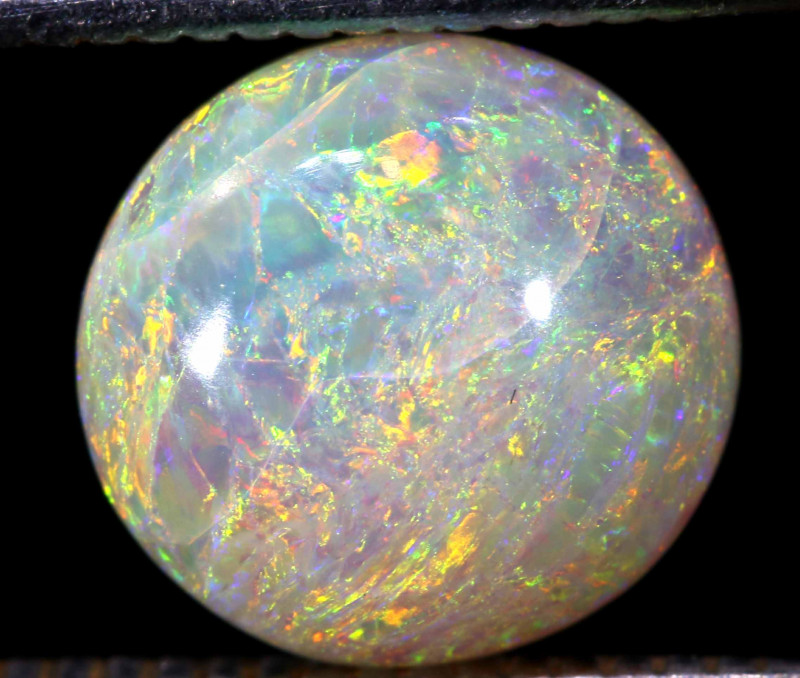
White Opal a ɛyɛ fitaa
White opal , anaa light opal, betumi aba ahorow a wɔtaa de di dwuma anaasɛ ɛsom bo. Akyi a ɛyɛ hare no kyerɛ sɛ ɔbo no play-of-color no nyɛ saturated saa. Mmeae pii na wɔyɛ opal fitaa, nanso South Australia ne beae a agye din sen biara.
 Opal a ɛyɛ tuntum
Opal a ɛyɛ tuntum
Opal tuntum ne opal ahorow a wɔn kɔn dɔ sen biara. Common black opal wɔ hɔ nanso enkura bo koro no ara a ɛsom bo a ɛyɛ black opal. Wɔ akyi a ɛyɛ sum no so no, kɔla agodie da adi pefee. Wonim Lightning Ridge, Australia, ne Honduras sɛ wɔyɛ opal tuntum.
Crystal Opal na ɔkyerɛwee
Crystal opal betumi akyerɛkyerɛ opal biara a ɛyɛ mmerɛw mu, sɛ́ ɛyɛ nipadua mu nne a ɛyɛ hare anaa esum. Australia ne Ethiopia na ɛwɔ hɔ a ɛdɔɔso sen biara.
Ogya Opal
Wɔ mfiridwuma mu no, ogya opal betumi afi mmeae nyinaa aba, nanso nea aban de no ne Mexico ogya opal . Saa opal ahorow yi wɔ ahorow a wɔtaa de di dwuma na ɛsom bo na ɛda nipadua mu nne a ɛyɛ ma na ɛyɛ hyew adi.
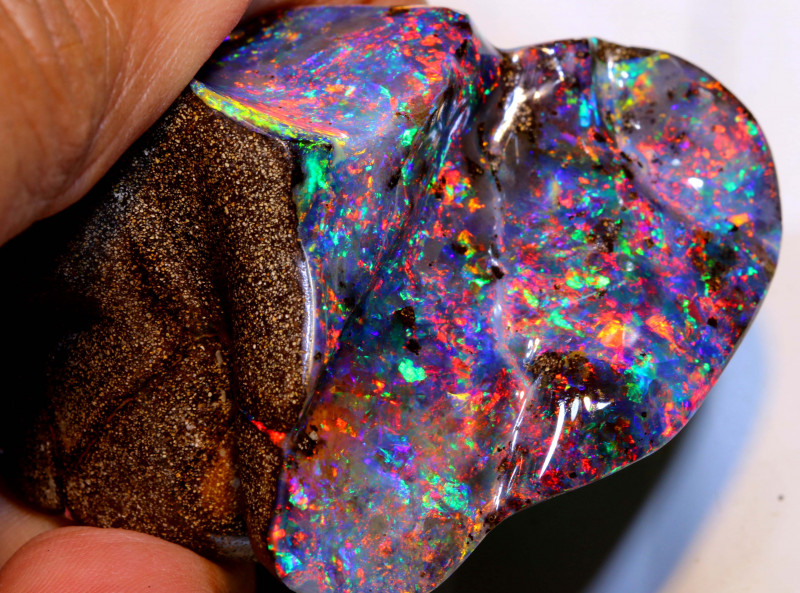
Ɔbotan a wɔfrɛ no Opal
Boulder opal kyerɛ opal a ɛsom bo a ɛda so ara bata ɔbotan a ɛyɛ ahɔho ho, a opal no wɔ mu anaasɛ ɛwɔ soro. Ɔbotan no yɛ abɔde mu akyigyina, na sɛ ɔbotan no yɛ sum a, kɔla a wɔde di agoru no da adi kɛse. Ɛkame ayɛ sɛ wotu abotan so opal nyinaa wɔ Queensland, Australia.
Matrix Opal na ɛyɛ adwuma
Te sɛ boulder opal no, matrix opal kyerɛ opal a ɛsom bo a ɛne ne host rock abɔ mu. Mpɛn pii no, abotan a ɛwɔ hɔ no yɛ nea ɛyɛ nsu a ɛtɔ gu fam, baabi a silica-nsu no petepete ɔbotan no mu mpaapaemu nyinaa ansa na ayɛ den.
Abotan bi a ɛwɔ hɔ no yɛ ogya, baabi a silica-nsu no taa si mineral grains ananmu. Sedimentary matrix opal fi Andamooka, Australia, bere a igneous matrix opal no dodow no ara wɔ Honduras.
Nanso, ɛnyɛ opal nyinaa na abɔde na ɛbɔɔ.
Na Synthetic Opals nso ɛ?
Opals a wɔayɛ no yɛ opals a nnipa ayɛ a wɔde silica kurukuruwa nketenkete na ɛyɛ, mpɛn pii no silica a nsu wom nanso ɛnyɛ bere nyinaa. Ebia resin wɔ opal a wɔde ayɛ opal , bere a wɔfrɛ opal a wɔde ayɛ a resin nnim no “opal a wɔabɔ.”
Nyansahufo fii ase yɛɛ opals a wɔayɛ wɔ 1970 mfe no mu na wɔayɛ akwan horow fi saa bere no. Opal ahorow abien a wɔde ayɛ a agye din ne Monarch Opal ne Bello Opal.
Nsonsonoe biako a ɛho hia: opal a wɔayɛ no ne opal a wɔayɛ no sɛnea wɔyɛ no nyɛ ade koro. Opal a wɔayɛ no hwehwɛ sɛ wɔde nnuru a wɔde yɛ opal ne nea ɛma ɛyɛ mmerɛw te sɛ abɔde mu opal, bere a wɔde nneɛma afoforo te sɛ resin anaa plastic na ɛyɛ opal a wɔayɛ no sɛnea ɛte no.
Opal Kɔla ahorow
Opal kɔla ahorow no fi nneɛma a ɛnyɛ den a ɛyɛ den te sɛ tuntum ne fitaa kosi nyankontɔn nne a ɛwɔ kɔla ahorow pii ntam. Nanso, opal kakraa bi na ɛda kɔla biako pɛ adi.
Sɛnea wɔkyerɛ ase no, opal ahorow a ɛsom bo da kɔla ahorow adi wɔ afã horow. Opal a wɔtaa de di dwuma mpo a enni kɔla a wɔde di agoru no taa nya kɔla ahorow a wɔde ka ho anaasɛ nsusuwso te sɛ nkorabata a ɛyɛ tumm a ɛwɔ dendritic opal mu no.
Nneɛma atitiriw a ɛde kɔla ahorow a wɔde di agoru ba ne sɛnea abo no kurukuruwa nketenkete no kɛse ne sɛnea ɛyɛ pɛ, ne sɛnea wufi so hwɛ ɔbo no.
Opal nipadua nne , anaa akyi kɔla, di dwuma wɔ kɔla afoforo a wohu wɔ ne soro no mu. Fitaa ne opal kɔla a abu so sen biara , bere a tuntum ne kɔkɔɔ na ɛho yɛ na sen biara.
Opal kɔla ahorow a agye din sen biara ne wɔn soro kɔla ahorow a ɛne no hyia ni:
White : Nipadua a ɛyɛ fitaa anaasɛ ɛyɛ krim; Ɛda kɔla ahorow a ɛyɛ pastel adi.
Tuntum : Nipadua a ɛyɛ tuntum anaa tuntum; Mpɛn pii no ɛda ahabammono ne bruu a ɛhyerɛn adi.
Pink : Rose, salmon, anaa ballet nipadua a ɛyɛ pink; Ɛtɔ mmere bi a, ɛwɔ nsensanee tuntum a ɛyɛ borɔdɔma anaa tuntum.
Blue : Nipadua a ɛyɛ bruu-akuturuku, cyan, anaa anadwo fã bruu; Mpɛn pii no, ɛwɔ nsensanee a ɛyɛ borɔdɔma anaa asase so nnyigyei.
Ogya: Nipadua a ɛyɛ kɔkɔɔ, borɔdɔma, anaa kɔkɔɔ a ɛhyerɛn; Mpɛn pii no, nneɛma ahorow a ɛsom bo da neon a ɛyɛ ahabammono ne kɔkɔɔ adi.
Enti, sika ahe na opal ahorow yi mu biara bɛbɔ wo?
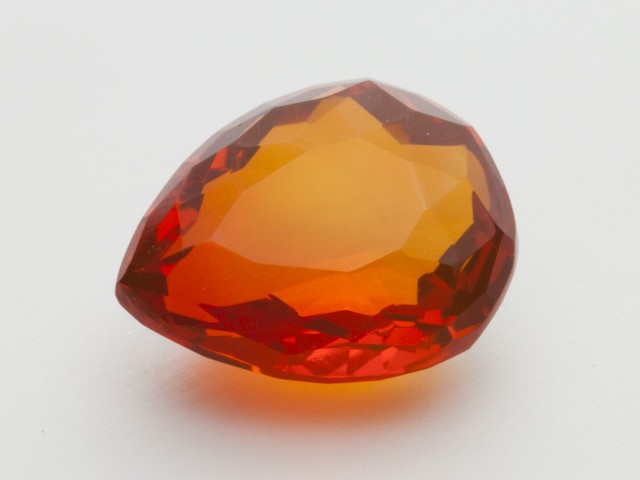
Opal Botae a Ɛsom Bo
Sɛnea wunim no, nneɛma pii na ɛma wobu opal sɛ ɛsom bo . Sɛ wɔrekyerɛ bo a, kɔla ne ade titiriw a edi kan, na ɛno akyi no, kɔla a wɔde di agoru wɔ hɔ.
Ɛsono bo a wɔbɔ wɔ opal carat biako ho te sɛ opal ankasa. Abo a ɛba fam no betumi ayɛ bɛyɛ dɔla 10 wɔ carat biako mu, bere a opal a ɛyɛ papa no betumi ayɛ dɔla 6,000 anaa nea ɛboro saa wɔ carat biako mu.
Opal tuntum a ɛsom bo hyɛ bo a ɛkɔ soro esiane sɛ ɛho yɛ na na ɛyɛ kɔla a wɔde di agoru a ɛhyerɛn nti, na edu dɔla 10,000 wɔ carat biako anaa nea ɛboro saa mu. Opals a wɔtaa tɔ no bo yɛ den kɛse, efi ase fi $10 wɔ carat biara mu na ɛkɔ soro gyina kɔla a emu yɛ den, nea ɛda adi pefee, ne nea ɛhyerɛn so.
Ɛmfa ho sɛnea ne bo te no, sɛnea wubehu sɛnea wobɛhohoro opal ho no ho hia na ama woakɔ so ayɛ kɔla ahorow na ayɛ nea enni dɛm.
Cleaning & Caring a wobɛhwɛ wo Opal
Wɔ opal dodow no ara fam no, wubetumi de brɔs a ɛyɛ mmerɛw ne nsu a ɛyɛ hyew a samina wom asiesie ɔbo no . Nsu a ɛyɛ hyew, samina, ne ngo rempira wo opal no gye sɛ ɛyɛ doublet anaa triplet. Ɛsɛ sɛ wɔde ntama a ɛyɛ mmerɛw siesie doublet ne triplets.
Ɛtɔ mmere bi a, sɛ woma opal yɛ hyew a, ebetumi ayɛ tuntum, enti ma ɛntra baabi a ogyaframa a ɛbue anaa ɔhyew a ɛboro so ntra hɔ na ama kɔla no akɔ so atra hɔ na atra hɔ akyɛ.
Ahorow ahorow bi wɔ wɔn ankasa akwankyerɛ a wɔde hwɛ sɛnea wɔhwɛ so. Matrix opal yɛ porous na ɛnsɛ sɛ wɔde gu biribiara mu kyɛ. Nanso Virgin Valley opal , de, ɛsɛ sɛ wɔde nsu gu mu na amma abɔ dam.
Hu Opal no ma Wo!
Na ɛno ara ne no! Esiane nokwasɛm ahorow a ɛyɛ nsu ne nsɛm nketenkete a ɛwɔ akwankyerɛ yi mu nyinaa nti, woasiesie wo ho sɛ wode wo opal nimdeɛ a ɛtrɛw no bɛma obiara ani agye. Nea ɛka ho no, wowɔ nnwinnade a wode ahotoso bɛtɔ bere a woapaw opal a w’ani gye ho no. Anigye a wobɛtɔ ade!
Kɔtɔ Opals fi Opal Auctions nnɛ!
搜尋Opal Encyclopedia
相關拍賣
相關文章
Boulder Opal yɛ opal a ne bo nyɛ den a ɛsom bo wɔ gua so no mu biako. Sua pii fa opal soronko yi ho na hwehwɛ abo a ɛyɛ fɛ a yɛwɔ a yɛtɔn no mu.
29th May 2019
Esiane sɛ Wayne ne Estella Sedawie ani gye opals ho nti, wɔde Opal Plus sii hɔ bɛboro mfe 14 a atwam ni na wɔahu sɛ intanɛt yɛ adwinnade a ɛsom bo. Ɛhɔ na adwumakuw no amanaman ntam nkitahodi dodow no ara kɔ so.
17th Oct 2018
Ɔbo a wɔde yɛ October no ne aboɔden abo a yɛpɛ paa, Opal. efi Black Opals, Mexico Opals ne Ethiopian Opals nyinaa yɛ soronko te sɛ nnipa a wɔwoo wɔn wɔ October mu no
3rd Oct 2019
最新的文章
Black opals ne opal ahorow a wɔhwehwɛ sen biara, na ne nnyinaso a emu dɔ ma nyankontɔn a ɛyɛ hann wɔ soro. Hu sɛnea wɔde opal tuntum di dwuma, ne su, abakɔsɛm, ne bo a ɛsom!
7th Dec 2025
Hu sɛnea wɔde opal ahorow hyehyɛ mu ne nneɛma a ɛka ne bo. Efi kɔla ne hann so kosi nea wɔatwa ne nea efi mu ba so, sua sɛnea wɔbu opal ahorow biara bo - a nhwɛso ne bo ahorow.
19th Jul 2023
Bra akwantuo mu na sua opals ayaresa tumi ho asɛm firi yɛn ahɔhoɔ kyerɛwfoɔ Vivien Schapera a ɔfiri Crystal Healing Techniques hɔ!
20th May 2023
文章類別
All there is to know about Opals including Black Opals, Ethiopian Opals & Boulder Opal
14文章
Check out our fascinating information and articles on all things amazing in the Opal world
41文章








